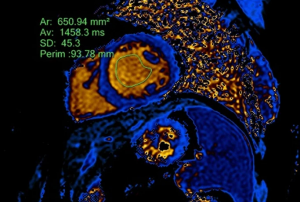Our scientists focused on the formula for calculating the hematocrit
Cardiovascular magnetic resonance imaging is one of the most advanced non-invasive methods of obtaining information about the heart and its function. One of the methods used is T1 mapping, which allows to measure the extracellular (interstitial) volume of the heart muscle, as one of the important markers of cardiovascular diseases.
T1 mapping uses measured T1 relaxation time values obtained before and after administration of a gadolinium contrast agent. However, the hematocrit value, which is the proportion of red blood cells to total blood volume, is also important for accurate calculation. In the study, researchers from the Cardiovascular Magnetic Resonance team at the International Clinical Research Centre at St. Anne’s University Hospital Brno and the I. IKAK of St. Anne’s University Hospital Brno focused on determining it using values obtained directly during T1 mapping. This method greatly simplifies the whole procedure and is already used in some centres, but a comprehensive overview of calculation methods has not been published yet. In addition to determining the best method of calculation, the researchers also attempted to further refine the formula by adding the values obtained after the application of the contrast agent.
For this purpose, they used values obtained by measuring 139 patients. “We first measured hematocrit values using standard laboratory techniques, then used cardiovascular magnetic resonance to determine the T1 relaxation times of the blood before and after contrast agent administration and used statistical methods to determine the relationship between these values. Subsequently, we investigated the accuracy of the calculation with each type of formula using conventional formulas, calibrated statistically for our department and then adding post-contrast values,” said Dr. Lukáš Opatřil.
In the end, the reciprocal model of the formula calibrated for the workplace proved to be the most accurate and the addition of post-contrast values further improved its accuracy significantly. “Using this calculation could unify and refine this time- and cost-efficient method in the future,” said Dr Opatřil.
The final formula and the full study can be found here:




